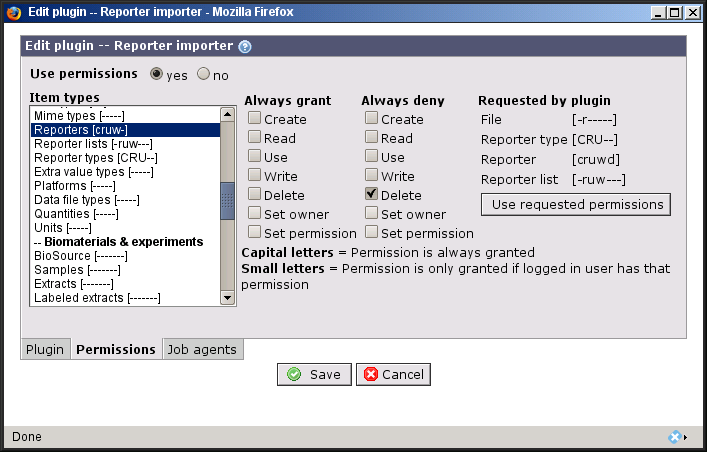When a plug-in is executed the default is to give it the same permissions as the user that started it. This can be seen as a security risk if the plug-in is not trusted, or if someone manages to replace the plug-in code with their own code. A malicious plugin can, for example, delete the entire database if invoked by the root user.
To limit this problem it is possible to tune the permissions for a plug-in so that it only has permission to do things that it is supposed to do. For example, a plug-in that import reporters may only need permission to update and create new reporters and nothing else.
To enable the permission system for a plug-in go the edit view of the plug-in and select the Permissions tab.
- Use permissions
Select if the plug-in should use the permission system or not. If no is selected, the rest of the form is disabled.
- Item types
The list contains all item types found in BASE that can have permissions set on them. The list is more or less the same as the permission list for roles. See the section called “Permissions”.
- Always grant
The selected permissions will always be granted to the plug-in no matter if the logged in user had the permission to begin with or not. This makes it possible to develop a plugin that allows users to do things that they are normally not allowed to do. The reporter importer is for example allowed to create and use reporter types.
- Always deny
The selected permissions will always be denied to the plug-in no matter if the logged in user had the permission to begin with or not. The default is to always deny all permissions. Permissions that are not always denied and not always granted uses permissions from the logged in user.
- Requested by plug-in
To make it easier for the server administrator to assign permissions, the plug-in developer can let the plug-in include a list of permissions that are needed. Plug-in developers are advised to only include the minimal set of permissions that are required for the plug-in to function. Click on the button to give the plug-in the requested permissions.
